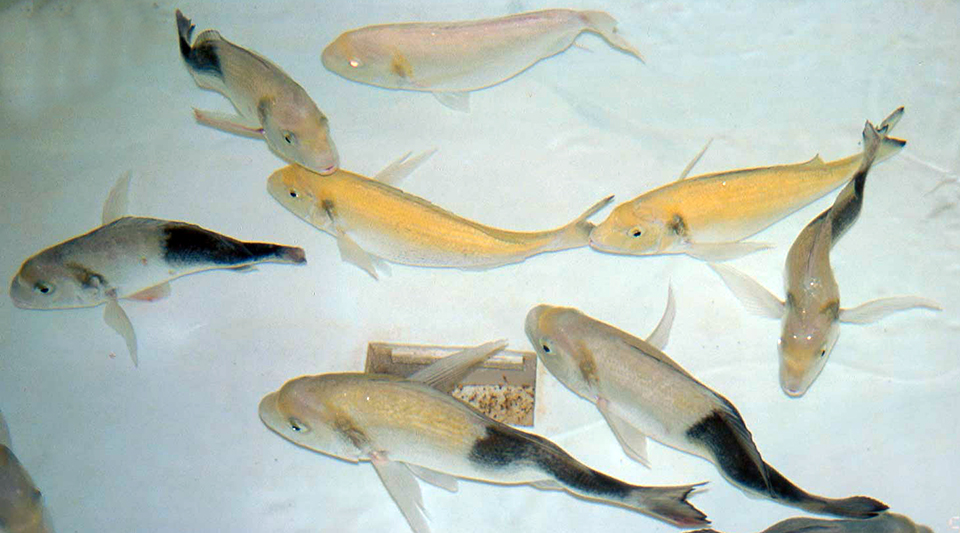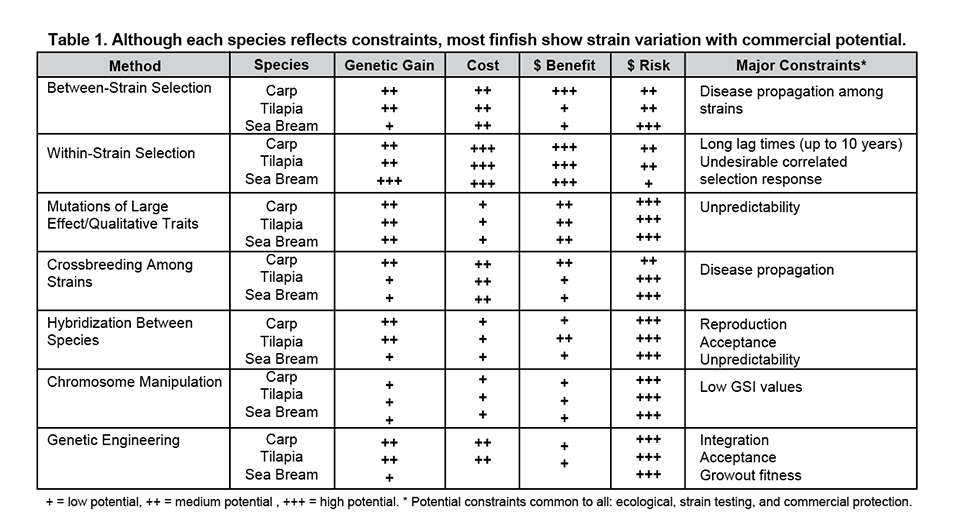Methods, values for sea bream, other species

Many aquaculture industries fail to enhance productivity and competitiveness with genetic improvement. This may be due, in part, to uncertainty over which methods should be used. Indeed, genetics comprises many subdisciplines, each with advocates who promote one field or another as the best approach. For the Mediterranean sea bream, as well as other species, various genetic methods have been employed to advance commercial value.
Benefits of genetic improvement
Genetic improvement programs can shape cultured animals to suit a given purpose or environment – as is evident, for example, in the variety of the foods we consume. Genetic programs can produce many benefits, including important economic ones.
Increased productivity, reliability
Genetic improvement is often the primary method used to increase productivity in terrestrial agriculture. Nearly all the 300-400 percent growth improvement of broiler chicken strains since the 1950s was due to selection. Faster growth translates into greater production with existing facilities and, often, improved food-conversion efficiency.
Today, chicken is inexpensive, of uniform quality and appearance, and reliable in supply. Unfortunately, the reverse is typical of many commercial species of marine fish.
Increased profitability, new industry
Long-term profit margins for commodity aquaculture companies are usually narrow. For marginal companies that operate with 5 percent profit, even modest genetic gains of 10 percent can double profits. For sea bream, where profitability is constrained by environmental regulations and limits on sea cages, genetically improved strains can increase production with existing infrastructure. In addition, new “seed” industries that produce eggs and fingerlings for local or overseas markets can develop from genetic improvement programs.
Resistance to pathogens
The emergence of new pathogens is almost predictable in farmed Mediterranean sea bream and European sea bass. The development of fish strains that are genetically resistant to important pathogens is one approach to this problem.
Improved ROI
Genetic gains compound with each generation of selection, and economic value is proportional to the size of the industry. It is possible to calculate with some precision the return on investment for genetic breeding programs (e.g., 1:15 for salmon, 1:50 for pigs).
Selection among strains
Strains differ in their growth and survival performance. The choice of the best existing strains could equal the genetic gains made by years of within-strain selection using inferior strains. Hence, strain testing should precede within-strain selection.
Most finfish species, including sea bream, carp, and tilapia, show some strain variation for growth, disease resistance, or cold tolerance. To varying degrees, these differences have been exploited in commercial farms (Table 1).

Selection within strains
Within-strain selection can have various objectives (e.g., traits that contribute to profit) using different selection criteria. Individuals can be ranked with information from themselves, from their relatives, or using additional information.
Genetic differences, gains
Selection response cannot occur unless there are genetic differences among individuals that can be inherited by offspring. Luckily, most populations have genetic differences for commercial traits. For example, in Israel, an industrial mass-selection program increased body weight in sea bream 5 to 10 percent per generation.
Elsewhere, selection response has been achieved for disease resistance, body weight, and body proportion in carp, and body weight in tilapia. Most selection experiments for body weight in finfish have yielded gains of 10-20 percent per generation.
Optimize accuracy
It is generally desirable to optimize the accuracy of selection and increase response. However, optimization can incur high costs for tagging and management to obtain pedigree information. Cost-benefit analyses of genetic options for each species should be conducted to calculate total costs and gains from different types of selection.
Business evaluation
In addition to genetic constraints, the business evaluation of selection options should consider temporal, biological, and technical constraints. Without feasibility studies, businesses should adopt proven genetic technologies, rather than technologies without precedent of commercial success.
Traits, genes, and mutations
Unlike growth, thought to be due to many loci with minor effects, some traits are due to one or few loci. Various single-gene mutations, including ebony, yellow, and white body color, have been isolated for sea bream. The ebony mutation is heterotic growth, used for commercial protection of the improved strains. However, overall, there are few qualitative traits of commercial value in foodfish aquaculture. Examples include red body color in tilapia and scale patterns in carp.
Crossbreeding
In terrestrial agriculture, crossbreeding between different strains of the same species can produce heterosis and uniformity. For sea bream, commercial crossbreeding is used to limit inbreeding in selection lines. Indeed, for most aquaculture applications, crossbreeding should be considered simply as the reverse of inbreeding, rather than as a method to achieve gains over the base outbred population.
Hybrids
Hybrids between species are created to combine parental traits like fast growth and tolerance to disease or temperature, or produce single-sex offspring. They can also be used to achieve superior performance or sterility.
Hybrids usually resemble the average of their parents. Given the large number of attempts to produce new fish hybrids, remarkably few (apparently less than 1 percent, and none for sea bream) have resulted in sustained commercial production.
Chromosome manipulation
The potential applications for chromosome set manipulations in fish are diverse. They include growth acceleration (with triploids via suppression of gonadal development), same-sex offspring, rapid inbreeding, and restoration of whole fish from cryopreserved sperm.
However, in practice, triploid sea bream have little growth acceleration. A similar conclusion has been reached for triploid carp. Many fish triploids have been produced, but except for some salmonids, little information exists regarding their commercial performance, and few are actually used by farmers. Even so, ecological issues may sustain future research on sterile and triploid fish.

Genetic engineering
Presently, there is no commercial use of genetically engineered fish. But genetic engineering could be used to minimize inbreeding in wild and captive populations.
Without formal genetics programs, local industries often attempt selection in house, with few broodstock individuals and small effective population sizes. Even without deliberate selection, farm management typically results in severe inbreeding and domestication selection. Managed genetics programs usually attempt to minimize inbreeding.
Conclusion
In theory, there are many methods to genetically improve fish strains. In practice, few improved strains have reached the industry, and of these, most have been developed with traditional selection that exploits additive genetic variance. Those strains that have reached the aquaculture industry, however, have been of substantial economic value.
(Editor’s Note: This article was originally published in the February 2002 print edition of the Global Aquaculture Advocate.)
Now that you've finished reading the article ...
… we hope you’ll consider supporting our mission to document the evolution of the global aquaculture industry and share our vast network of contributors’ expansive knowledge every week.
By becoming a Global Seafood Alliance member, you’re ensuring that all of the pre-competitive work we do through member benefits, resources and events can continue. Individual membership costs just $50 a year. GSA individual and corporate members receive complimentary access to a series of GOAL virtual events beginning in April. Join now.
Not a GSA member? Join us.
Author
-
Wayne Knibb, Ph.D.
Bribie Island Aquaculture Research Centre
144 North Street, Woorim
P.O. Box 2066
Bribie Island
Queensland 4507 Australia
Tagged With
Related Posts

Intelligence
Byproduct utilization for increased profitability, part 5
Fish protein hydrolysates have been used in the food industry for the development of antioxidants, emulsifiers, flavoring agents, anti-bacterial agents and feed. As natural products, they have a growing acceptance, since natural products are preferred by some consumers over industrial products.

Aquafeeds
Feed study examines effects of fishmeal storage
A study investigated the effects of storage temperature and duration on the quality of finished fishmeal fed to juvenile shrimp. Diets with 15 percent fishmeal were stored at 4 or 30 degrees-C for six months or 12 months.

Innovation & Investment
Unleashing the genetic potential of black tiger shrimp
The black tiger shrimp is the second most important, farmed shrimp species globally. Because of its importance in Australia, the new ARC Hub for Advanced Prawn Breeding will develop a scalable, advanced breeding program for the species as well as bring its genetic knowledge to a level comparable to that of livestock.

Health & Welfare
Screening probiotic bacteria for Atlantic cod larvae
The addition of probiotic bacteria to marine larvae can reduce pathogenic bacteria and subsequent infection by establishing a protective flora on the mucosal surfaces of the larvae.


